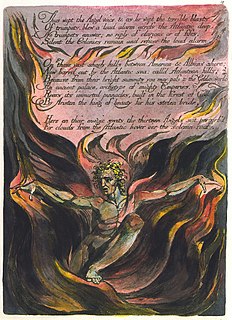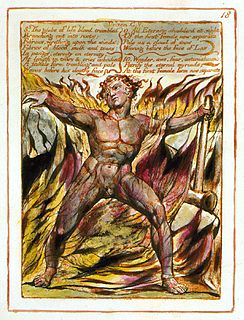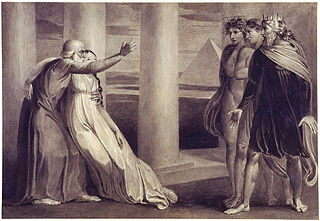Deism is the philosophical position and rationalistic theology that generally rejects revelation as a source of divine knowledge, and asserts that empirical reason and observation of the natural world are exclusively logical, reliable, and sufficient to determine the existence of a Supreme Being as the creator of the universe. Or more simply stated, Deism is the belief in the existence of God solely based on rational thought without any reliance on revealed religions or religious authority. Deism emphasizes the concept of natural theology.

William Blake was an English poet, painter, and printmaker. Largely unrecognised during his life, Blake is now considered a seminal figure in the history of the poetry and visual art of the Romantic Age. What he called his "prophetic works" were said by 20th-century critic Northrop Frye to form "what is in proportion to its merits the least read body of poetry in the English language". His visual artistry led 21st-century critic Jonathan Jones to proclaim him "far and away the greatest artist Britain has ever produced". In 2002, Blake was placed at number 38 in the BBC's poll of the 100 Greatest Britons. While he lived in London his entire life, except for three years spent in Felpham, he produced a diverse and symbolically rich collection of works, which embraced the imagination as "the body of God" or "human existence itself".

In the mythology of William Blake, Urizen is the embodiment of conventional reason and law. He is usually depicted as a bearded old man; he sometimes bears architect's tools, to create and constrain the universe; or nets, with which he ensnares people in webs of law and conventional society. Originally, Urizen represented one half of a two-part system, with him representing reason and Los, his opposition, representing imagination. In Blake's reworking of his mythic system, Urizen is one of the four Zoas that result from the division of the primordial man, Albion, and he continues to represent reason. He has an Emanation, or paired female equivalent, Ahania, who stands for Pleasure. In Blake's myth, Urizen is joined by many daughters with three representing aspects of the body. He is also joined by many sons, with four representing the four elements. These sons join in rebellion against their father but are later united in the Last Judgment. In many of Blake's books, Urizen is seen with four books that represent the various laws that he places upon humanity.

Orc is a proper name for one of the characters in the complex mythology of William Blake. A fallen figure, Orc is the embodiment of rebellion, and stands opposed to Urizen, the embodiment of tradition.

Isaac Newton was considered an insightful and erudite theologian by his Protestant contemporaries. He wrote many works that would now be classified as occult studies, and he wrote religious tracts that dealt with the literal interpretation of the Bible. He kept his heretical beliefs private.

The Book of Urizen is one of the major prophetic books of the English writer William Blake, illustrated by Blake's own plates. It was originally published as The First Book of Urizen in 1794. Later editions dropped the "First". The book takes its name from the character Urizen in Blake's mythology, who represents alienated reason as the source of oppression. The book describes Urizen as the "primeaval priest" and narrates how he became separated from the other Eternals to create his own alienated and enslaving realm of religious dogma. Los and Enitharmon create a space within Urizen's fallen universe to give birth to their son Orc, the spirit of revolution and freedom.

The Book of Ahania is one of the English poet William Blake's prophetic books. It was published in 1795, illustrated by Blake's own plates.

The prophetic books of the 18th-century English poet and artist William Blake are a series of lengthy, interrelated poetic works drawing upon Blake's own personal mythology. They have been described as forming "what is in proportion to its merits the least read body of poetry in the English language". While Blake worked as a commercial illustrator, these books were ones that he produced, with his own engravings, as an extended and largely private project.

In the mythological writings of William Blake, Los is the fallen form of Urthona, one of the four Zoas. He is referred to as the "eternal prophet" and creates the visionary city of Golgonooza. Los is regularly described as a smith, beating with his hammer on a forge, which is metaphorically connected to the beating of the human heart. The bellows of his forge are the human lungs. Los's emanation, Enitharmon, represents spiritual beauty and embodies pity, but at the same time creates the spatial aspect of the fallen world, weaving bodies for men and creating sexual strife through her insistence upon chastity. In the Book of Urizen (1794), Los and Enitharmon have a child, Orc, who is the embodiment of the spirit of revolution. The name Los is, by common critical acceptance, an anagram of Sol, the Latin word for "sun". Los is also the plural form of El, an ancient Hebrew deity. Such innovations are common in many of Blake's prophetic poems.

Tiriel is a narrative poem by William Blake, written c.1789. Considered the first of his prophetic books, it is also the first poem in which Blake used free septenaries, which he would go on to use in much of his later verse. Tiriel was unpublished during Blake's lifetime and remained so until 1874, when it appeared in William Michael Rossetti's Poetical Works of William Blake. Although Blake did not engrave the poem, he did make twelve sepia drawings to accompany the rough and unfinished manuscript, although three of them are considered lost as they have not been traced since 1863.

Europe a Prophecy is a 1794 prophetic book by the British poet and illustrator William Blake. It is engraved on 18 plates, and survives in just nine known copies. It followed America a Prophecy of 1793.

Vala, or The Four Zoas is one of the uncompleted prophetic books by the English poet William Blake, begun in 1797. The eponymous main characters of the book are the Four Zoas, who were created by the fall of Albion in Blake's mythology. It consists of nine books, referred to as "nights". These outline the interactions of the Zoas, their fallen forms and their Emanations. Blake intended the book to be a summation of his mythic universe but, dissatisfied, he abandoned the effort in 1807, leaving the poem in a rough draft and its engraving unfinished. The text of the poem was first published, with only a small portion of the accompanying illustrations, in 1893, by the Irish poet W. B. Yeats and his collaborator, the English writer and poet Edwin John Ellis, in their three-volume book The Works of William Blake.

America a Prophecy is a 1793 prophetic book by the English poet and illustrator William Blake. It is engraved on eighteen plates, and survives in fourteen known copies. It is the first of Blake's Continental prophecies.

The Song of Los is one of William Blake's epic poems, known as prophetic books. The poem consists of two sections, "Africa" and "Asia". In the first section Blake catalogues the decline of morality in Europe, which he blames on both the African slave trade and enlightenment philosophers. The book provides a historical context for The Book of Urizen, The Book of Ahania, and The Book of Los, and also ties those more obscure works to The Continental Prophecies, "Europe" and "America". The second section consists of Los urging revolution.

William Blake drew and painted illustrations for John Milton's nativity ode On the Morning of Christ's Nativity between 1803 and 1815. A total of 16 illustrations are extant: two sets of six watercolours each, and an additional four drawings in pencil.

The Book of Los is a 1795 prophetic book by the English poet and painter William Blake. It exists in only one copy, now held by The British Museum. The book is related to the Book of Urizen and to the Continental prophecies; it is essentially a retelling of Urizen from the point of view of Los. The book has been described as a rewriting of the ancient myth of creation that equates fall with the loss of spiritual vision brought about by selfhood.
Deism, the religious attitude typical of the Enlightenment, especially in France and England, holds that the only way the existence of God can be proven is to combine the application of reason with observation of the world. A Deist is defined as "One who believes in the existence of a God or Supreme Being but denies revealed religion, basing his belief on the light of nature and reason." Deism was often synonymous with so-called natural religion because its principles are drawn from nature and human reasoning. In contrast to Deism there are many cultural religions or revealed religions, such as Judaism, Trinitarian Christianity, Islam, Buddhism, and others, which believe in supernatural intervention of God in the world; while Deism denies any supernatural intervention and emphasizes that the world is operated by natural laws of the Supreme Being.

All Religions are One is a series of philosophical aphorisms by William Blake, written in 1788. Following on from his initial experiments with relief etching in the non-textual The Approach of Doom (1787), All Religions are One and There is No Natural Religion represent Blake's first successful attempt to combine image and text via relief etching, and are thus the earliest of his illuminated manuscripts. As such, they serve as a significant milestone in Blake's career; as Peter Ackroyd points out, "his newly invented form now changed the nature of his expression. It had enlarged his range; with relief etching, the words inscribed like those of God upon the tables of law, Blake could acquire a new role."

There is No Natural Religion is a series of philosophical aphorisms by William Blake, written in 1788. Following on from his initial experiments with relief etching in the non-textual The Approach of Doom (1787), All Religions are One and There is No Natural Religion represent Blake's first successful attempt to combine image and text via relief etching, and are thus the earliest of his illuminated manuscripts. As such, they serve as a significant milestone in Blake's career; as Peter Ackroyd points out, "his newly invented form now changed the nature of his expression. It had enlarged his range; with relief etching, the words inscribed like those of God upon the tables of law, Blake could acquire a new role."
Catholicism and Deism are two theologies that have opposed each other in matters of the role of God in the world. Deism is the philosophical belief which posits that although God exists as the uncaused First Cause, responsible for the creation of the universe, God does not interact directly with that subsequently created world. As deism is not organized, its adherents differ widely in important matters of belief, but all are in agreement in denying the significance of revelation in Catholic Scripture and Tradition. Deists argue against Catholicism by either, only considering Scripture to be a helpful moral tool, or denying: its divine character, the infallibility of the Church and Traditions, and the validity of its evidence as a complete manifestation of the will of God. Deism is first considered to have manifested itself in England towards the latter end of the seventeenth century.



















